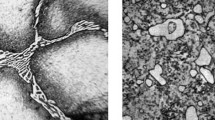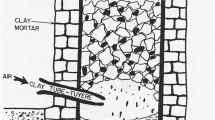Abstract
Crucible Damascus blades are hypereutectoid steels forged from small ingots. In the past, the crucibles have always been tightly sealed and the surface patterns on the blades resulted from a banded cementite/pearlite microstructure. This work shows that, firstly, the blades may be made using crucibles open to the air. Secondly, blades can also be made with the same type of surface patterns as on traditional crucible Damascus blades, but instead of the patterns being produced by a banded cementite/pearlite microstructure they are produced by a banded cementite/spheroidite microstructure. The spheroidite structure is an array of fine spherical carbides in a ferrite matrix produced by the divorced eutectoid transformation. Finally, the study adds support to experiments showing that the formation of the sheets of aligned cementite particles during forging, that in turn produce the banded microstructure, requires the presence of low amounts of carbide forming elements, notable V and Cr.










Similar content being viewed by others
References
J.D. Verhoeven, A.H. Pendray, and W.E. Dauksch, J. Met. 50(9), 56 (1998).
J.D. Verhoeven, A.H. Pendray, W.E. Dauksch, and S.R. Wagstaff, J. Met. 70, 1331 (2018).
K. Hoda and S. Saito, J. Iron Steel Inst. 102, 261 (1920).
J.H. Whiteley, J. Iron Steel Inst. 105, 339 (1922).
P. Payson, W.L. Hodapp, and J. Leeder, Trans. ASM 28, 306 (1940).
T. Oyama, O.D. Sherby, J. Wadsworth, and B. Walser, Scr. Met. 18, 799 (1984).
J.D. Verhoeven and E.D. Gibson, Metall. Mater. Trans A 29A, 1181 (1998).
L.E. Samuals, Light Microscopy of Carbon Steels (ASM International, Netherland, 1999), p 177.
J.D. Verhoeven and A.H. Pendray, Mat. Charact. 30, 175 (1993).
J.D. Verhoeven, Metall. Mater. Trans. A 31A, 2431 (2000).
J.D. Verhoeven, F. Laabs, A.H. Pendray, and W.E. Dauksch, I.S.S. Trans., Iron Steelmak. 25(11), 65 (1998).
Acknowledgements
Mark Schmidt at Nucor Steel, Darlington, South Carolina, USA, provided the chemical analyses. The metallography and thermal cycling equipment were provided by the MSE Department of Iowa State University, USA.
Author information
Authors and Affiliations
Corresponding author
Ethics declarations
Conflict of interest
On behalf of all authors, the corresponding author states that there is no conflict of interest.
Additional information
Publisher's Note
Springer Nature remains neutral with regard to jurisdictional claims in published maps and institutional affiliations.
Rights and permissions
About this article
Cite this article
Hynninen, N., Verhoeven, J.D. & Dauksch, W.E. A New Method for Making Crucible Damascus Steel Blades. JOM 74, 2484–2491 (2022). https://doi.org/10.1007/s11837-022-05261-9
Received:
Accepted:
Published:
Issue Date:
DOI: https://doi.org/10.1007/s11837-022-05261-9




